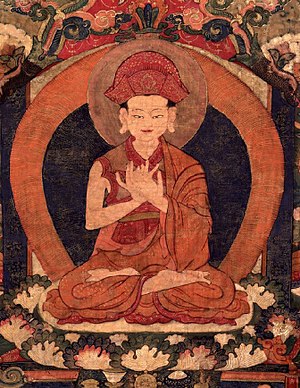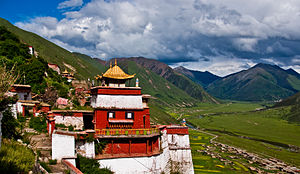Drikung Kagyu
Drikung Kagyu (T. 'bri-gung bka'-brgyud) is one of the Kagyü subschools (more specifically one of the eight Pagdru Kagyü subschools) founded in the twelfth century by Drikung Kyobpa Jikten Sumgön (1143-1217)—one of the eight main disciples of Phagmodrupa Dorje Gyalpo, as well as a disciple of the great Nyingma tertön Nyang Ral Nyima Özer.
Drikung Kyobpa Jikten Sumgön founded the main seat of the Drikung Kagyü school: the Drikung Til Monastery (Wyl. 'bri gung mthil dgon pa), aka Changchub Ling (Wyl. byang chub gling) in Central Tibet, in 1179.
The Drikung Kagyü school is present today in Tibet, India and Ladakh, and unites both the major Kagyü and Nyingma traditions. This school is famous for its specific phowa practice.[1]
Ringu Tulku Rinpoche writes:
- ...The Drikung Kagyü lineage has a unique teaching called the Sole Intention of the Drikung (Wyl. dgongs gcig), as well as the Essential Point of the Drikung (Wyl. theg chen bstan pa'i snying po), five Mahamudra teachings, and many other collected works and teachings that continue to this day.[2]
Teaching and practice

The unique doctrines of Drikung Kagyu as taught by its founder, Jigten Sumgön is preserved in "The Single Intention" or "One thought of Drikung" (Drikung Gonchik, Wylie: dgongs gcig)[3] and "The Essence of Mahāyāna Teachings" (Wylie: theg chen bstan pa'i snying po). According to Jampa MacKenzie Stewart, the Gonchik "recasts Buddhism in a fascinating and innovative form, emphasizing each aspect as being capable of revealing the full process of enlightenment."[4]
The main practices of Drikung Kagyu are “The Five-fold Profound Path of Mahamudrā,” and “The Six Dharmas of Nāropa.” The five-fold Mahamudrā, also known as the "possessing five", consists of five elements:[5]
- Setting the motivation, arousing bodhichitta,
- Deity yoga, generating the Yidam. The main deity in Drikung is Chakrasamvara (in union with consort Vajravarahi), but Milarepa taught this method by using Chenrezig.
- Guru yoga
- Mahamudrā meditation (Samatha and Vipasyana)
- Dedication of merit.
This practice is traditionally cultivated in retreat alongside the Six Dharmas of Naropa, and it is preceded by the preliminary practices called ngondro.[6]
This presentation is outlined in Clarifying the Jewel Rosary of the Profound Five-Fold Path by Kunga Rinchen, the Dharma heir to Jigten Sumgön.
The Drikung Kagyu also have a tradition of Dzogchen teachings, the Yangzab Dzogchen.[7] It is based on termas revealed by the Drikung Tertön (hidden treasure revealer), Rinchen Phuntsog in the sixteenth century.
Monasteries and centers
The first and main Drikung Kagyu monastery is Drikung Thil Monastery,[8] founded in 1179[8] by Jigten Sumgön[8] approximately 150 kilometers northeast of Lhasa.
Aside from the Drikung Valley in Ü, the Drikung Kagyu has a strong presence in Nangqên County in what was Kham, in western Tibet (including Kailash), and in Ladakh. Tsari and Lapchi - two important sacred sites for all Tibetan Buddhists - also have a strong Drikung Kagyu presence. Among the so-called "four major and eight minor" Kagyu lineages, Drikung Kagyu is one of four Kagyu lineages that continue to exist as independent institutions (the other three being the Karma Kagyu, Drukpa Lineage and Taklung Kagyu).
Outside of Tibet, the headquarters for the tradition in exile is Jangchubling, located in Dhera Dun, in the Indian state of Uttarakhand.[9]
Drikung Kagyu is one of the most prominent lineages in Ladakh where its main monasteries are Phyang and Lamayuru, with roughly 50 other monasteries spread across Ladakh region.
A series of Drikung Dharma centers were also founded in the West, a project begun by Drikung Kyabgon Chetsang Rinpoche in 1978.[10]
References
- ↑
 Drikung Kagyü, Rigpa Shedra Wiki
Drikung Kagyü, Rigpa Shedra Wiki
- ↑ Ringu Tulku, The Ri-me Philosophy of Jamgön Kongtrul the Great (Boston & London: Shambhala Publications, 2006), page 180.
- ↑ For the Gongchig see the blog by Jan-Ulrich Sobisch (Copenhagen University) dgongs1.com.
- ↑ Steward, Jampa MacKenzie (2004), The Life of Gampopa, Shambhala, p. 130.
- ↑ Drikung Kyabgon Chetsang Rinpoche (2009), The Practice of Mahamudra, Shambhala, pp. 11-12.
- ↑ Drikung Kyabgon Chetsang Rinpoche (2009), The Practice of Mahamudra, Shambhala, pp. 13-14.
- ↑ Helmut Krasser, Tibetan studies, International Association for Tibetan Studies. Verlag der Österreichischen Akademie der Wissenschaften, 1997 - Tibet (China), page 586
- ↑ 8.0 8.1 8.2 A Brief History of the Drikung Kagyu Lineage of Tibetan Buddhism
- ↑ Gruber, Elmar R., From the Heart of Tibet: The Biography of Drikung Chetsang Rinpoche, the Holder of the Drikung Kagyu Lineage, Shambhala Publications, 2010, Foreword by the Dalai Lama.
- ↑ Lewis, James R. The Encyclopedia of Cults, Sects, and New Religions, p. 290.
External links
- Drikung Kagyu Official website
- Garchen Institute
- Drikung Baltics
- Ratnashri Sweden
- Drikung Kagyu Om Center Singapore
| This article includes content from Drikung Kagyü on Rigpawiki (view authors). Licensed under CC BY-NC 3.0 |
| This article includes content from Drikung Kagyu on Wikipedia (view authors). License under CC BY-SA 3.0. |


